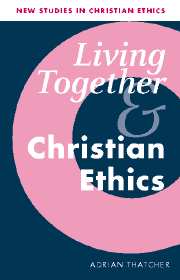Book contents
- Frontmatter
- Contents
- General editor's preface
- Acknowledgments
- PART 1 LIVING TOGETHER AS A THEOLOGICAL PROBLEM
- PART 2 AN EXERCISE IN RETRIEVAL: BRINGING BACK BETROTHAL
- PART 3 EXTENDING THE MARITAL NORM
- 7 Betrothal, consent and consummation
- 8 The sacramental beginning of marriage
- 9 Extending the marital norm
- Appendix: A Rite of Betrothal before Marriage
- Bibliography
- Index
7 - Betrothal, consent and consummation
Published online by Cambridge University Press: 04 August 2010
- Frontmatter
- Contents
- General editor's preface
- Acknowledgments
- PART 1 LIVING TOGETHER AS A THEOLOGICAL PROBLEM
- PART 2 AN EXERCISE IN RETRIEVAL: BRINGING BACK BETROTHAL
- PART 3 EXTENDING THE MARITAL NORM
- 7 Betrothal, consent and consummation
- 8 The sacramental beginning of marriage
- 9 Extending the marital norm
- Appendix: A Rite of Betrothal before Marriage
- Bibliography
- Index
Summary
The shape of this final part of the book will be determined by the two key outlined concepts in part 1, the ‘marital norm’ (above, p. 53) and the ‘betrothal solution’ (above, p. 61). It is time to clinch the arguments set out earlier (above, p. 71) which relied on substantiating the premiss that betrothal can be reclaimed. I take part 2 as having demonstrated the truth of several claims, e.g., that betrothal has played a major part in the history of Christian marriage; that its demise was due to historical (and not theological) circumstances; that the churches' proclamation and liturgical celebration of marriage has been weakened by a conspicuous lack, a forgetfulness of their marital heritage. Of course sceptics may wearily concede some or all of the historical arguments mounted in part 2, yet object that they do not indicate that betrothal can be ‘reclaimed’: all they show is that it was once much more pronounced than it now is, and it is neither necessary, desirable, or even possible to reinstate it. Part 3 addresses such sceptics, but its primary aim is to indicate the advantages of reinstatement, pastorally, theologically and liturgically.
I capitalize on parts 1 and 2 by building on them in part 3. Chapter 7 draws on a recent treatment of marriage as a path to holiness, and argues (first section) that this treatment is better articulated and commended if betrothal is incorporated into it.
- Type
- Chapter
- Information
- Living Together and Christian Ethics , pp. 211 - 236Publisher: Cambridge University PressPrint publication year: 2002



